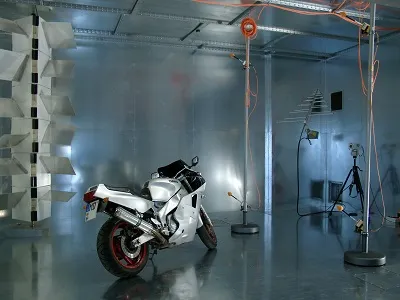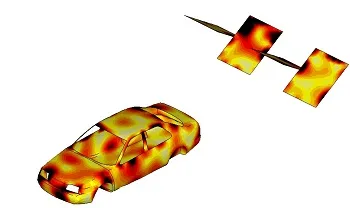Electromagnetic Compatibility
Electromagnetic compatibility deals with the unintentional propagation of electromagnetic waves. For example, consider a cell phone nearby a speaker which receives a text message. The electromagnetic wave carrying the text message will unintentionally couple to the speaker and cause an unwanted noise. In more crucial applications, like communications, medicine, and security applications, the immunity of devices to unintentional electromagnetic waves has to be ensured.
To test the electromagnetic compatibility of devices, reliable and economical testing environments are necessary. Besides the well established anechoic chambers, reverberation chambers have become more and more popular during the last decades. A reverberation chamber is a rectangular, high conductive, over-moded cavity. The chamber usually contains a transmitting and a receiving antenna, a divice under test, and a mode-stirrer [4].
The mode-stirrer is rotated to generate a statistically uniform electromagnetic environment similar to the electromagnetic environment in urban scenarios. In summary, the concept of a reberberation chamber is comparable to that of a microwave oven. But instead of cooking food, the electromagnetic compibility of electronic devices is tested.
The numerical modeling of reverberation chambers could not only serve as an important complement to measurements, but also contribute to the ongoing research on reverberation chambers (e. g.: How should the optimal stirrer look like? What is an appropriate and easy-to-implement measure for the efficiency of a stirrer? [5]).
Because of their resonant nature, the numerical modeling of reverberation chambers is challenging. Commercial numerical solvers often fail to produce accurate results within reasonable time.
At our institute, we develop a numerical solver specialized for the modeling of reverberation chambers [2] [3]. A boundary integral formulation is employed. But instead of the free-space Green’s function, we use the Green’s function of the rectangular cavity. A fast spectral domain approach accelerates the computation of the system matrix and reduces the complexity of our algorithm.
Literatur
| [1] | Dr. Hans Georg Krauthäuser.The (large) Electromagnetic Reverberation Chamber at the Otto-von-Guericke-University Magdeburg, Magdeburg, Germany. 21.11.2005. URL: \url{http://en.wikipedia.org/wiki/File:Magdeburg-reverberation-chamber.jpg}. |
| [2] | M. E. Gruber, S. B. Adrian und T. F. Eibert. »A finite element boundary integral formulation using cavity Green’s function and spectral domain factorization for simulation of reverberation chambers«. In: International Conference on Electromagnetics in Advanced Applications (ICEAA). 2013, S. 460–463. |
| [3] | M. E. Gruber und T. F. Eibert. »Simulation of Reverberation Chambers Using Method of Moments with Cavity Green’s Function and Spectral Domain Factorization«. In: IEEE International Symposium on Electromagnetic Compatibility. 2013. |
| [4] | H.G Krauthäuser. »Grundlagen und Anwendungen von Modenverwirbelungskammern«. Diss. Otto-von-Guericke-Universität Magdeburg, 2007. |
| [5] | Niklas Wellander, Olof Lundn und Mats Bäckström. »Experimental Investigation and Mathematical Modeling of Design Parameters for Efficient Stirrers in Mode-Stirred Reverberation Chambers«. In: IEEE Trans. Electromagn. Compat. 49.1 (2007), S. 94-103. |

